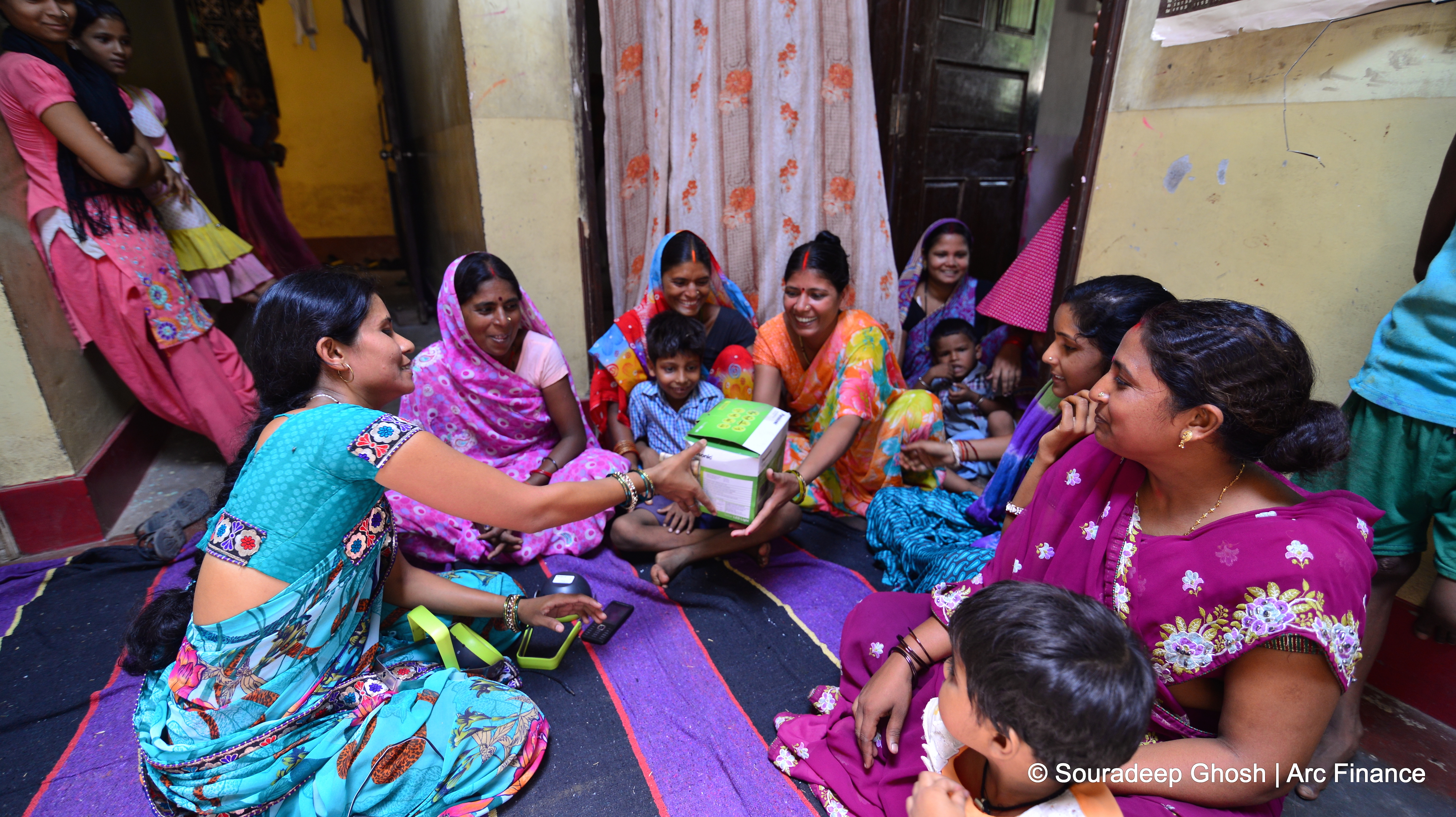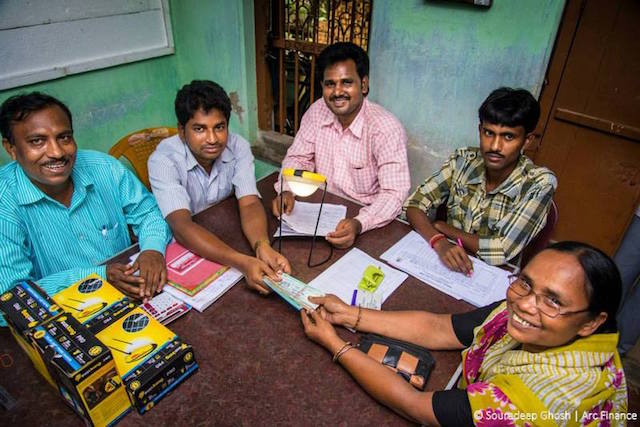Creating a New Business Opportunity for Sogexpress
Sogexpress, Haiti’s largest money transfer organization, facilitates over US$500 million annually in remittance flows between members of the country’s diaspora population residing in the United States and their family in Haiti. The company identified a powerful business opportunity in a critical unmet need, and in 2012 began to lay the groundwork for a new venture that would market high quality, locally manufactured solar lighting and charging devices to its growing retail customer base nationwide. Read our Case Study (PDF). ►
Sarala’s Energy Lending Program
Sarala Development and Microfinance is a microfinance institution (MFI) operating in Northeastern India. With the support of the Partnership to Advance Clean Energy–Deployment Technical Assistance (PACE-D TA) Program, Sarala has launched and quickly scaled a clean energy lending program for its microfinance client base. In just under two years, Sarala has helped over 100,000 women access clean energy, improving clients’ quality of life with reliable and clean energy,and reduced dependence on harmful traditional fuels. Read the Case Study (PDF).►
Saija’s Energy Lending Initiative
Saija Finance Private Limited is a microfinance institution (MFI) operating in Northern and Eastern India. With the support of the Partnership to Advance Clean Energy–Deployment Technical Assistance (PACE-D TA) Program, Saija has piloted and scaled both a hybrid Loan Office/Energy Office business model and solar lighting energy lending program for its clients which has dually increased its own institutional capacity and helped thousands of poor households get access to clean energy to reduce the use of harmful traditional fuels and improve their livelihoods. Read the Case Study (PDF).►
Bandhan’s Energy Lending Initiative
Bandhan Konnagar is part of the Bandhan Group, which provides microfinance services to 7.6 million borrowers — almost all women — through 2,022 branches across 24 Indian states. In 2013, Bandhan created an energy program to provide a microfinance facility for high-quality solar devices. Bandhan aims to harness the enormous scale of its existing microfinance business to scale its energy lending activities, and transform millions of lives by making modern energy services accessible to India’s rural poor. Read our Case Study (PDF). ►
Simpa Networks Brings “Pay-as-You-Go” to Rural Consumers
Simpa Networks uses asset finance to provide electricity to off-grid rural communities through modular, expandable Solar Home Systems (SHSs). Through its proprietary “Progressive Purchase” metering technology, Simpa’s clients pay to use their Solar Home Systems through monthly pre-paid installments, and own the assets by the end of the period, making solar technology “radically affordable” and bringing the social and economic benefits of modern energy to underserved communities. Read our Case Study (PDF). ►
SolarNow Brings Asset Finance for Solar to Rural Customers
SolarNow uses asset finance to provide electricity to off-grid rural communities through modular, expandable Solar Home Systems (SHSs). The SolarNow approach is to integrate an increasing range of energy efficient appliances into the company’s product line, a tactic that both improves lives and increases demand for its energy systems. Established as a social enterprise in May 2011, SolarNow grew out of the Rural Energy Foundation, a Dutch run NGO providing distribution and training support for the use of SHSs across Africa. Read our Case Study (PDF). ►
Milaap Uses Crowdfunding to Catalyze Energy Microfinance
Founded in 2010, Milaap is a Bangalore-based social enterprise that deploys online lending and other innovative funding methods to fill the existing capital gap for microfinance institutions (MFIs) interested in building lending portfolios for energy, water and other essential services. By channeling low-cost, flexible loan capital from an expanding base of both online and offline lenders to a select group of MFI field partners, Milaap is directly impacting the lives of a growing number of poor people throughout rural India. Read our Case Study (PDF). ►
Using Remittances to Finance Clean Energy: Inspiring the Haitian Diaspora to Combat Climate Change
Haiti has one of the lowest electricity access rates in the world, with only 12.5% of its population legally connected to the grid. Remittances offer a new solution for helping to finance the purchase and distribution of energy devices. Given its energy needs, and the size and location of its diaspora-based population, Haiti was an ideal country to test a remittances-backed business model for clean energy. The model uses remittance flows to facilitate the purchase and distribution of small-scale renewable energy devices, thereby fostering the use of clean and efficient energy technology among the energy-poor. Read our Case […]
FWWB-I’s Solar Microloan Initiative — Leveraging a Network to Reach India’s Most Isolated Region
In 2009, Friends of Women’s World Banking-India (FWWB-I), an apex microfinance organization, added energy access to its mandate when it collaborated with five partner institutions to launch a solar lantern credit initiative in the conflict-rife state of Manipur. This pioneering effort has helped catalyze the Indian microfinance sector to initiate energy-lending programs. Read our Case Study (PDF). ►
NWTF’s Business Partner Model — Bolstering Both Energy Demand and Supply Through Microfinance
Negros Women for Tomorrow Foundation (NWTF), an MFI based in the Philippines, launched energy operations in 2009. Since then it has continuously modified its approach, experimenting with new methods of engaging its staff and clients to realize its impact objectives. This case study surveys a sample of the key adaptations that the organization has made to increase impact and sales, as well as improve the long-term sustainability of its program. Read our Case Study (PDF). ►
XacBank’s Eco-Banking Department — Improving Air Quality with Credit, Carbon Finance and Smart Subsidies
Ulaanbaatar, Mongolia ranks as one of the most polluted urban areas on the planet. In 2009, XacBank, Mongolia’s largest microfinance institution (MFI), made a commitment to address this public health threat head-on. XacBank’s evolving model combines innovative approaches to product development, quality assurance, consumer education, logistics and distribution. XacBank is also among the first MFIs to leverage carbon revenues to help sustain operations. Read our Case Study (PDF). ►
The Buksh Foundation’s Solar Loan Initiative — Sparking a “Clean Energy Movement” in Pakistan
The Buksh Foundation, a Pakistani MFI, takes a unique approach to addressing a critical need that is faced by virtually all of its business clients: lack of access to reliable and affordable electricity. In 2010, the organization began to explore clean energy finance as a solution to this escalating challenge. Today, Buksh Foundation’s solar loan program is taking direct aim at the problem, and has emerged as the fastest growing area of its portfolio. Read our Case Study (PDF). ►
Solar Sister’s Energy Consignment Model — Women Micro-Retailers Drive Solar Product Adoption in East Africa
Founded in 2010, Solar Sister brings affordable solar lamps and small solar systems to communities in East Africa. Using an Avon-style distribution system, Solar Sister creates vital access to clean energy technology by building and extending the supply chain through women’s rural networks. Read our Case Study (PDF). ►
UpEnergy’s Carbon Credit Initiative — Driving Down the Costs of Clean Cookstove Adoption
UpEnergy is a San Francisco-based social enterprise that is a leader in the use of carbon credits in developing markets. It finances, builds, and supports distribution channels for products such as high efficiency cookstoves, water purification technologies, and solar lights using carbon credit mechanisms. In Uganda, UpEnergy has focused on cookstoves since launching in October 2011. Read our Case Study (PDF). ►
Stima Systems’ Group Microleasing Model — Promoting Payment and Reducing Risk at the Group Level
Kenya-based energy company Stima Systems has developed a distinct approach to service delivery and end-user affordability: the group microlease. Group microleasing leverages the prevalence, structure and internal dynamics of community-based savings groups to mitigate a number of critical risks and barriers that often limit access to clean energy for poor people around the world. Read our Case Study (PDF). ►



